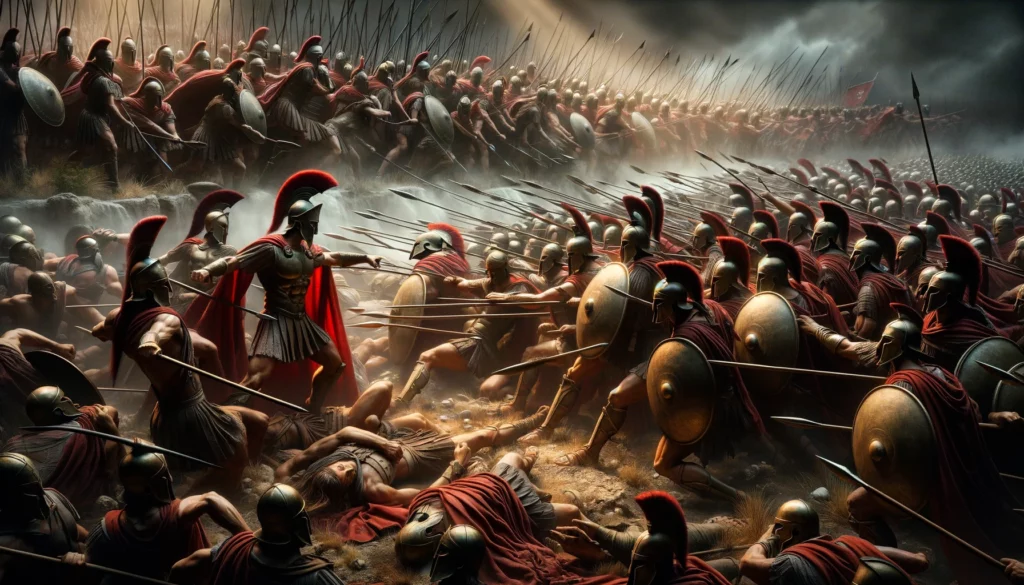Picture a society where military might and laconic wit define the very fabric of its existence. This was Sparta, an enigmatic powerhouse in ancient Greece, renowned for its fearless warriors and stoic discipline. The city-state, a titan of the classical era, stands today as a symbol of martial excellence. Yet, it’s the untold story of its fall that grips our curiosity. How did such a formidable force come to an end? To understand this, we journey back in time to the era of hoplites and helots, exploring the pivotal moments that led to the Spartan downfall.
Why Sparta’s Decline Matters
The tale of Sparta’s fall transcends mere historical curiosity; it is a narrative rich with lessons in power dynamics, societal structure, and military strategy. This saga serves as a testament to the transient nature of power and the perils of overreliance on a singular strength. It offers a window into the complexities of ancient societies and their struggles, resonating with the contemporary discussions on the rise and fall of civilizations.

The Catalysts of Decline
- Military Overextension and the Peloponnesian War: Sparta’s involvement in the prolonged Peloponnesian War (431–404 BC) against Athens stands as a prime example of military overextension. While the Spartans emerged victorious, the victory came at a steep cost. The decades-long conflict drained Spartan resources, both in terms of manpower and finances. Spartan warriors, famed for their commitment to war, faced continuous battles, leading to significant losses that were difficult to replenish due to their rigid social system. Additionally, the war necessitated alliances with other states, notably Persia, which later proved problematic for Sparta’s autonomy and reputation.
- Societal Rigidity and the Helot Issue: Sparta’s social system, though effective for creating a powerful military, was also its Achilles’ heel. The society was divided into a few Spartan citizens, a larger group of perioeci (non-citizen inhabitants), and a vast population of helots, who were essentially serfs. The helots, who worked the land, were crucial to Spartan economy but were also constantly oppressed and feared due to their numbers. Periodic revolts by the helots demanded a significant portion of Spartan military resources to suppress, creating an environment of constant internal threat and preventing Spartan expansion or reform.
- Demographic Decline and Citizenship Crisis: Spartan citizenship laws were extremely stringent. A citizen had to trace his ancestry to the original inhabitants of the city, undergo the rigorous agoge training system, and contribute regularly to the common messes. Casualties in war, coupled with these strict criteria, led to a steep decline in the number of full citizens. By the late 5th century BC, the number of homoioi (Spartan citizens who had full rights) dwindled alarmingly, weakening the military capabilities and the political stability of Sparta.
- Economic Stagnation and Lack of Innovation: Unlike other Greek city-states, which thrived on commerce and innovation, Sparta remained an agrarian society, dependent largely on the helots for agriculture. Its economy was relatively primitive and non-commercial, leaving it behind as others progressed. Spartan disdain for trade and economic development meant that they were not able to build financial reserves, which became a crucial weakness, especially in maintaining a powerful army.
- Crucial Military Defeats and the Battle of Leuctra: The Battle of Leuctra in 371 BC, where Sparta was defeated by Thebes, marked a significant turning point. Led by the brilliant Theban general Epaminondas, the Theban army broke the myth of Spartan invincibility on the battlefield. This defeat not only cost Sparta many of its finest soldiers but also led to the liberation of Messenia, a territory essential for Spartan agriculture and economy, significantly weakening Spartan power and influence.
- Internal Decay and Revolts: Spartan society was also plagued by internal issues, including political strife and frequent revolts by the helots. The rigid Spartan system allowed for little flexibility or reform, leading to discontent among its own people and the oppressed helots. These internal conflicts further drained resources and weakened the state.
- Loss of Allies and Shifting Alliances: In the years following the Peloponnesian War, Sparta struggled to maintain its alliances and hegemony in the Greek world. The loss of Persian support, the growing power of Thebes, and the resurgence of Athens led to a significant shift in alliances. Sparta’s rigid diplomatic stance and inability to adapt to these changes left it isolated and without the support that had once bolstered its military campaigns.

The Enduring Legacy of Sparta
Sparta’s fall serves as a poignant reminder of the impermanence of power and the necessity of adaptability. The Spartan legacy, however, endures in the annals of history as a symbol of discipline, bravery, and military expertise. It invites us to ponder the complexities of human societies and the ever-changing dynamics of power.
What lessons do you believe modern societies can draw from the rise and fall of Sparta? Share your thoughts and join the conversation about this captivating chapter in history.